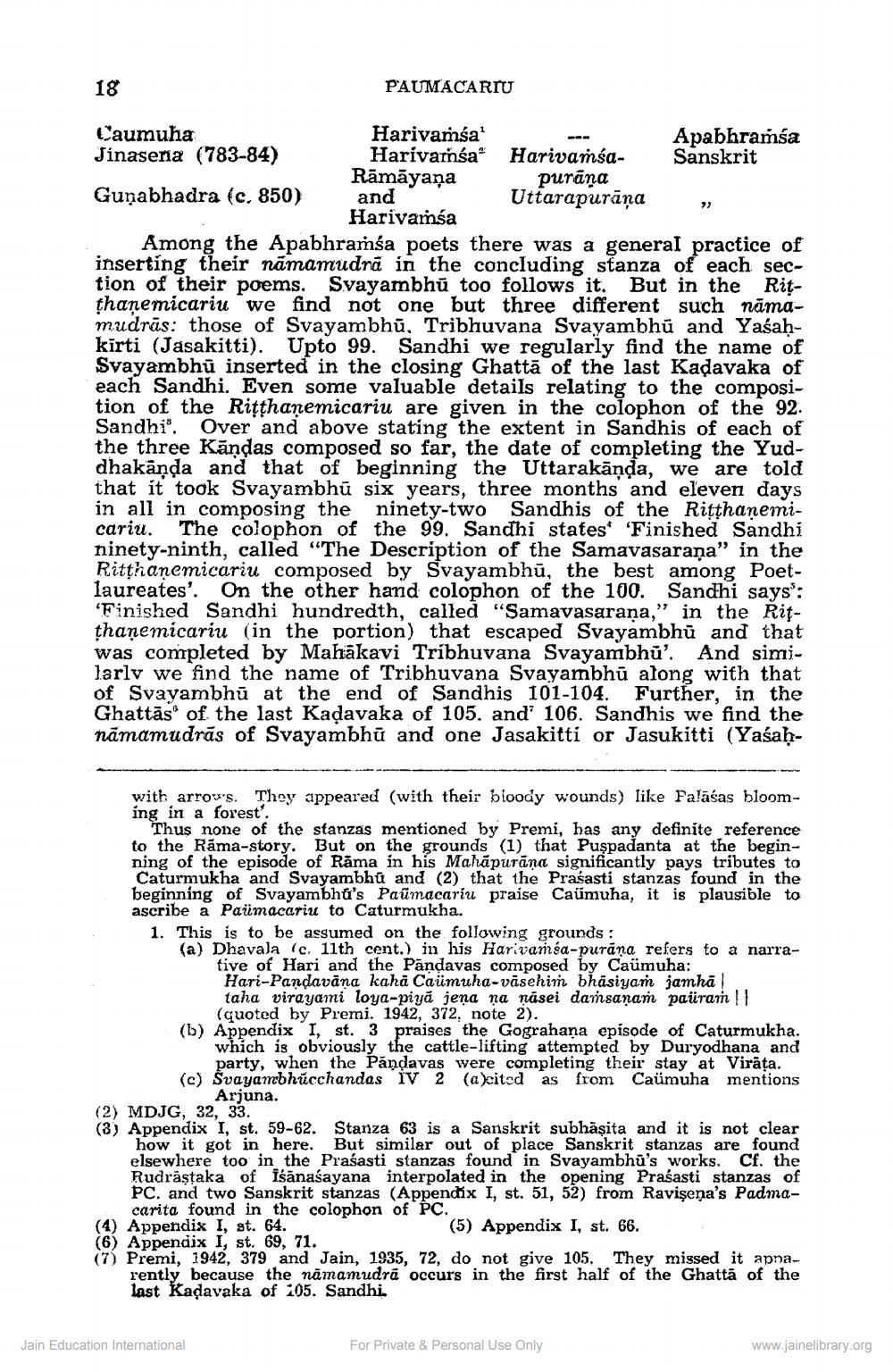________________
18
PAUMACARIU
Caumuha Harivamsa
Apabhramsa Jinasenia (783-84)
Harivarsa Harivansa- Sanskrit
Rāmāyana purana Gunabhadra (c, 850) and
Uttarapurāņa
Harivamsa Among the Apabhramśa poets there was a general practice of inserting their namamudra in the concluding stanza of each section of their poems. Svayambhū too follows it. But in the Ritthanemicariu we find not one but three different such namamudrās: those of Svayambhū, Tribhuvana Svayambhū and Yaśahkirti (Jasakitti). Upto 99. Sandhi we regularly find the name of Svayambhu inserted in the closing Ghattā of the last Kadavaka of each Sandhi. Even some valuable details relating to the composition of the Riţthaņemicariu are given in the colophon of the 92. Sandhi'. Over and above stating the extent in Sandhis of each of the three Kändas composed so far, the date of completing the Yuddhakāņda and that of beginning the Uttarakānda, we are told that it took Svayambhu six years, three months and eleven days in all in composing the ninety-two Sandhis of the Ritthanemicariu. The colophon of the 99. Sandhi states' 'Finished Sandhi ninety-ninth, called “The Description of the Samavasaraņa" in the Ritthanemicariu composed by Svayambhū, the best among Poetlaureates'. On the other hard colophon of the 100. Sandhi says": Finished Sandhi hundredth, called “Samavasarana," in the Ritthanemicariu (in the portion) that escaped Svayambhū and that was completed by Mahakavi Tribhuvana Svayambhu'. And similarly we find the name of Tribhuvana Svayambhū along with that of Svayambhū at the end of Sandhis 101-104. Further, in the Ghattās of the last Kadavaka of 105. and 106. Sandhis we find the namamudrās of Svayambhū and one Jasakitti or Jasukitti (Yasah
with arrow's. They appeared (with their bloody wounds) like Palāśas blooming in a forest'.
Thus none of the stanzas mentioned by Premi, has any definite reference to the Rāma-story. But on the grounds (1) that Puspadanta at the beginning of the episode of Rāma in his Mahāpurāna significantly pays tributes to Caturmukha and Svayambhu and (2) that the Prasasti stanzas found in the beginning of Svayambhu's Paūmacariu praise Caümuha, it is plausible to ascribe a Paümacariu to Caturmukha. 1. This is to be assumed on the following grounds : (a) Dhavala (c. 11th cent.) in his Harivaméa-purana refers to a narra
tive of Hari and the Pandavas composed by Caümuha: Hari-Pandavāna kahá Caümuha-vāsehim bhāsiyam jamha taha virayami loya-piyā jena na nasei dansanan paüram !!
(quoted by Premi. 1942, 372, note 2). (b) Appendix I, st. 3 praises the Gograhana episode of Caturmukha.
which is obviously the cattle-lifting attempted by Duryodhana and
party, when the Pandavas were completing their stay at Virata. (c) Svayambhúcchandas IV 2 (a)cited as from Caümuha mentions
Arjuna. (2) MDJG, 32, 33. (3) Appendix I, st. 59-62. Stanza 63 is a Sanskrit subhāşita and it is not clear
how it got in here. But similar out of place Sanskrit stanzas are found elsewhere too in the Praśasti stanzas found in Svayambhu's works. Cf. the Rudrāştaka of iśānaśayana interpolated in the opening Prasasti stanzas of PC. and two Sanskrit stanzas (Appendix I, st. 51, 52) from Ravişeņa's Padma
carita found in the colophon of PC. (4) Appendix I, st. 64.
(5) Appendix I, st. 66. (6) Appendix I, st. 69, 71.
Premi, 1942, 379 and Jain, 1935, 72, do not give 105. They missed it apnarently because the namamudra occurs in the first half of the Ghatta of the last Kadavaka of 205. Sandhi.
Jain Education International
For Private & Personal Use Only
www.jainelibrary.org




